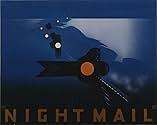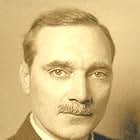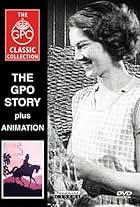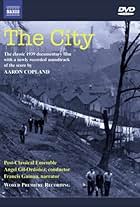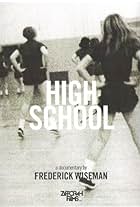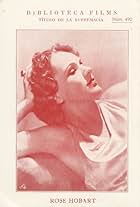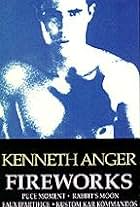IMDb RATING
6.8/10
1.5K
YOUR RATING
Shows the special train on which mail is sorted, dropped and collected on the run, and delivered in Scotland overnight.Shows the special train on which mail is sorted, dropped and collected on the run, and delivered in Scotland overnight.Shows the special train on which mail is sorted, dropped and collected on the run, and delivered in Scotland overnight.
Photos
- Directors
- Writers
- All cast & crew
- Production, box office & more at IMDbPro
Storyline
Did you know
- TriviaThe sound recordists equipment was unable to record a realistic sound of the mail train clattering over the joints in the track during the "two bridges and 45 beats" trackside mailbag collection sequence. Eventually they resorted to recording the sound of a model train being pushed back and forth over joints in a model railway track in time to the film of the man on the train counting the beats.
- GoofsAs the train approaches a signal box, it's pulling 12 carriages but there's only 8 in the shot of it going away, and some of them look like ordinary carriages rather than the fully enclosed mail ones.
- Quotes
Commentary: [Reciting W.H. Auden poem] This is the Night Mail crossing the Border, Bringing the cheque and the postal order, Letters for the rich, letters for the poor, The shop at the corner, the girl next door. Pulling up Beattock, a steady climb: The gradient's against her, but she's on time...
- ConnectionsFeatured in Hitchcock on Grierson (1965)
Featured review
The acknowledged leaders of documentary films for more than twenty years beginning in the 1930s were the British. The brilliant foundation English filmmakers' laid down in the 1930s carried over to the 1940s documenting their country's ordeal in World War Two. The famous 'British Documentary Film Movement' was led by one of its more popular early contributions, February 1936's "Night Mail."
Scotsman John Grierson was instrumental in the formation of United Kingdom's documentaries. As a film critic for the New York Sun, Grierson was the first to use the term "documentary" in his paper's review on Robert J. Flaherty's film 1926 "Moana." Later, he was named an assistant to the Empire Marketing Board (EMB) film production department.
At EMB Grierson produced his first documentary, the influential 1929 "Drifters," detailing the daily life of herring fishermen. When EMB closed its film unit in 1933 because of the Depression, Grierson and several colleagues relocated to the General Post Office (GPO), an improbable government agency where England's imprint in documentaries really took off.
England's General Post office was the largest employer in the country, numbering over 250,000. Its public relations office, with an adjunct film unit, spent more money than any other governmental agency informing the country about the operations of the GPO. "Night Mail" was produced to illustrate how the evening express mail train from London to Scotland was the lifeblood to innumerable communities along its route, delivering daily newspapers, important legal paperwork and simple 'feel-good' letters to its customers.
Explains film reviewer J. Watts, "'Night Mail' is one of the best known British documentaries of the 1930s and is often considered to be one of the best documentaries and best short films ever made." The 24-minute film was under the direction of Harry Watt, who relied on Basil Wright's research and script following the progress of heaps of mail originating from London's Euston Station and other points on their nightly journey to the London, Midland and Scottish Railway terminus. A dramatic highlight shows the train's collection of mail bags along the way without slowing down by snaring them on hanging poles. Conversely, when a hamlet's mail needed to be dropped off, the coordination between the train and the people on the ground was performed with split-second precision.
Meanwhile as the train raced throughout the countryside, mail was sorted onboard. The bucking of the train made it virtually impossible to get a steady shot, so a reproduction of the coach was built in the GPO studio. At first the set was shakened to simulate the train's movement, but Watt noticed the structure "just rattled like a sideboard in a junction town." The solution was to show a string hanging down and swinging. The postal worker 'actors' were told to sway at the same time as the string to fool its audiences.
Once the rough cut of "Night Mail" was seen, Grierson acknowledged the film captured the machinery of the overnight delivery system, but questioned "What about the people who write them and the people who get them?" A poem was inserted to be read in the film's coda. Famed poet W. H. Auden was hired to compose the concluding passage set to a Sergei Eisenstein-style of montage shots. "It's the final scenes of the film that turn 'Night Mail' into a little masterpiece," pointed out reviewer Watts. The poem made "Night Mail" a work of art and departs from the many other documentaries produced by GPO.
"Night Mail" proved to be a huge hit with the British public. Its popularity is so enduring that in 1987 an update on the documentary was produced, 'Night Mail II." The documentary format was so prominent in the United Kingdom that once the war was over, British dramatic feature films inserted an inordinate amount of documentary-style footage that gave its cinema a sense of realism that other countries eventually duplicated.
At EMB Grierson produced his first documentary, the influential 1929 "Drifters," detailing the daily life of herring fishermen. When EMB closed its film unit in 1933 because of the Depression, Grierson and several colleagues relocated to the General Post Office (GPO), an improbable government agency where England's imprint in documentaries really took off.
England's General Post office was the largest employer in the country, numbering over 250,000. Its public relations office, with an adjunct film unit, spent more money than any other governmental agency informing the country about the operations of the GPO. "Night Mail" was produced to illustrate how the evening express mail train from London to Scotland was the lifeblood to innumerable communities along its route, delivering daily newspapers, important legal paperwork and simple 'feel-good' letters to its customers.
Explains film reviewer J. Watts, "'Night Mail' is one of the best known British documentaries of the 1930s and is often considered to be one of the best documentaries and best short films ever made." The 24-minute film was under the direction of Harry Watt, who relied on Basil Wright's research and script following the progress of heaps of mail originating from London's Euston Station and other points on their nightly journey to the London, Midland and Scottish Railway terminus. A dramatic highlight shows the train's collection of mail bags along the way without slowing down by snaring them on hanging poles. Conversely, when a hamlet's mail needed to be dropped off, the coordination between the train and the people on the ground was performed with split-second precision.
Meanwhile as the train raced throughout the countryside, mail was sorted onboard. The bucking of the train made it virtually impossible to get a steady shot, so a reproduction of the coach was built in the GPO studio. At first the set was shakened to simulate the train's movement, but Watt noticed the structure "just rattled like a sideboard in a junction town." The solution was to show a string hanging down and swinging. The postal worker 'actors' were told to sway at the same time as the string to fool its audiences.
Once the rough cut of "Night Mail" was seen, Grierson acknowledged the film captured the machinery of the overnight delivery system, but questioned "What about the people who write them and the people who get them?" A poem was inserted to be read in the film's coda. Famed poet W. H. Auden was hired to compose the concluding passage set to a Sergei Eisenstein-style of montage shots. "It's the final scenes of the film that turn 'Night Mail' into a little masterpiece," pointed out reviewer Watts. The poem made "Night Mail" a work of art and departs from the many other documentaries produced by GPO.
"Night Mail" proved to be a huge hit with the British public. Its popularity is so enduring that in 1987 an update on the documentary was produced, 'Night Mail II." The documentary format was so prominent in the United Kingdom that once the war was over, British dramatic feature films inserted an inordinate amount of documentary-style footage that gave its cinema a sense of realism that other countries eventually duplicated.
- springfieldrental
- Jul 10, 2023
- Permalink
Details
- Runtime25 minutes
- Color
- Aspect ratio
- 1.37 : 1
Contribute to this page
Suggest an edit or add missing content


